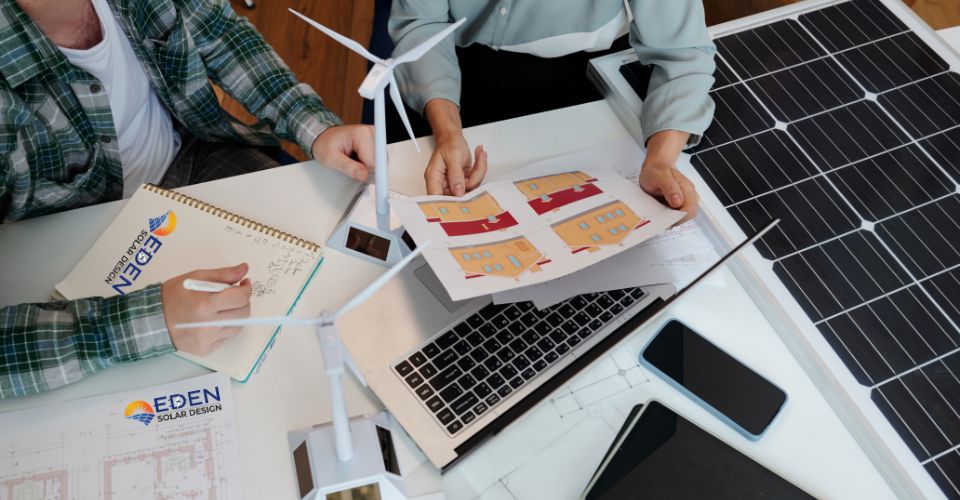Introduction: Why Design Is the Heart of Solar Execution
Solar energy systems may shine under the sun, but their success is built in the shade — at the design table.
In the rush to complete projects faster and cheaper, many solar EPCs and installers underestimate the value of a skilled, consistent, and responsive design team. But behind every smooth solar installation — one that gets permitted on time, installed without confusion, and inspected without redlines — there’s a team quietly ensuring every technical and regulatory box is checked.
At Eden Solar Design, we’ve worked behind the scenes on thousands of solar projects across the USA and India. This blog explores why design is not just the first step in a solar project — it’s the foundation of its success.
1. Design Builds the Blueprint for Execution
Every solar project — whether 5 kW residential or 5 MW utility — starts with a plan. The design defines:
Module layout and string sizing
Inverter selection and placement
Wire runs and conduit paths
Attachment methods and structural supports
A well-thought-out design:
Matches real-world site conditions
Follows code and AHJ requirements
Avoids last-minute field improvisation
With the right partner, your installers can show up to the site knowing exactly what to do.
“When our crews get designs from Eden, they know they won’t need to make guesses on-site. Everything’s there.” — Solar Installer, New Jersey
2. A Solid Design Team Minimizes Errors & Rework
Poor design creates expensive headaches:
Incorrect system sizing
Missing load calculations
Improper breaker or wire selection
Incomplete documentation for permitting
These issues can lead to:
Delayed inspections
Failed permits
Costly change orders
At Eden Solar Design, every project goes through our AQC (Auto Quality Check) system, ensuring:
NEC compliance (including NEC 2020)
Electrical and structural accuracy
Format-ready plan sets for AHJs
This reduces costly back-and-forth — and saves your team time and stress.
3. Good Design Speeds Up Permits and Inspections
One of the biggest slowdowns in solar projects is waiting for permit approval. AHJs reject plans that:
Lack necessary code citations
Miss details on roof attachments or setbacks
Use outdated templates
We’ve worked with 1000+ AHJs across all 50 U.S. states, and we know what each one expects. That means fewer rejections, faster reviews, and shorter project timelines.
“Our permit approvals improved dramatically once we started working with Eden. Their designs speak the AHJ’s language.” — EPC, Arizona
4. Design Helps Field Teams Avoid Site Surprises
Installers deal with enough surprises — unlevel roofs, unexpected shading, or tight electrical rooms. But poor design shouldn’t be one of them.
We design with field execution in mind:
Accurate placement of panels, inverters, disconnects
Clear diagrams and labels
Realistic wire paths
Structural details installers can trust
By the time your crew hits the job site, they should feel confident — not confused.
5. Professional Design Elevates Client Experience
Customers often evaluate your company based on the design package:
Is it clear?
Is it professional?
Does it instill confidence?
Our design packages are tailored to your brand. We offer:
Logo-integrated sheets
High-quality 3D renders for proposals
360° visualizations and production estimates
This makes your business look more capable and trustworthy in every proposal.
6. Your Team Shouldn’t Have to Be Design Experts
As an EPC, your core strength is project execution — not battling with NEC tables or AHJ codes.
Outsourcing design to a reliable partner like Eden Solar Design:
Frees up your time to focus on sales, procurement, and installations
Ensures technical accuracy and AHJ compliance
Reduces training burden on your staff
You get a dedicated extension of your team — without growing overhead.
7. Scalable Design = Scalable Business
What happens when your project volume increases? Most in-house teams struggle to scale fast. But a design partner like Eden is built for scalability.
Whether you need:
10 plans this week
100 plans next month
Multi-state coverage with PE stamps
We’re ready to deliver with consistency.
8. Eden Solar Design’s Process: From Request to Delivery
Here’s how we ensure smooth, fast, and accurate solar design delivery:
🔹 Step 1: Receive Your Inputs
Site survey
Panel and inverter specs
Design notes or templates
🔹 Step 2: Create the Design
3D layout (if needed)
Structural and electrical drawings
NEC, AHJ, and PE compliance
🔹 Step 3: Internal AQC Review
Layer-by-layer drawing check
Redline prevention review
Permit-readiness confirmation
🔹 Step 4: Final Delivery
PDF plan set
PE-stamped version (if required)
Revisions (if AHJ requests)
We ensure everything is ready for permit submission — and ready for install.
9. Our Services Support Every Stage of Your Project
We don’t just draw — we support the full lifecycle:
Pre-design proposals & 3D visualizations
Permit plan sets
PE stamps (structural & electrical)
Ground mount and rooftop post design
CEIG drawings for India
PVsyst generation reports
Whether you need just one or all, we’re here to help.
Conclusion: Let Us Help You Build Better Projects
Great installations start with great plans. When your design team knows how to blend compliance, clarity, and construction-minded precision — your installers work smoother, your permits get approved faster, and your clients stay happier.
At Eden Solar Design, we take pride in being the silent engine behind your solar success.






